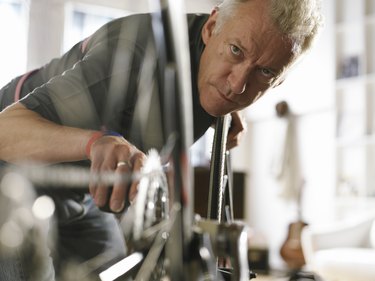
Shimano makes a variety of bicycle parts, including the XT rear derailleur. A rear derailleur is a spring-tension mechanism attached to the bike frame near the back wheel. It is part of the drivetrain and is necessary for your bike to shift gears. As you change gears using the shifter on your handlebars, the derailleur moves your chain to the corresponding cog on the cassette. When your gears fail to shift smoothly, it's a good idea to adjust the rear derailleur.
Step 1
Shift the derailleur down to the smallest cog on the chainring. Turn the barrel adjuster clockwise to leave room for adjusting it later. The barrel adjuster is the small round knob connected to the cable.
Video of the Day
Step 2
Locate the high limit screw. This is the upper screw across from the barrel adjuster. Use your screwdriver to rotate the screw. Rotating the screw clockwise moves the derailleur in; rotating counterclockwise adjusts the derailleur outward. For a good starting point, rotate the high limit screw to position the upper pulley directly beneath the smallest cog.
Step 3
Loosen the cable anchor by unscrewing it slightly. The cable anchor is located at the bottom portion of the derailleur. It holds the cable in place. Pull the cable tight, and then tighten the cable anchor. Turn the pedal to spin the wheel and start shifting the derailleur. You want it to shift smoothly. If it is catching, you need to tighten the barrel adjuster and low limit screw.
Step 4
Tighten the barrel adjuster by turning it clockwise. The barrel adjuster changes where the derailleur stops on the cog, altering the smoothness of the shifting as it climbs gears. Adjust the barrel adjuster so that the derailleur moves cleanly.
Step 5
Shift the derailleur to the largest cog and prepare to adjust the lower limit. Line the derailleur up underneath the largest cog. Use your screwdriver to begin adjusting the low limit screw, located directly beneath the high limit screw. Adjusting the screw too loosely can cause over-shifting. You typically want to adjust the low limit screw by turning it clockwise until you feel tension, but not so tight that you can't tighten anymore. Screwing it too tightly cause the derailleur to overshift, bumping into the drivechain.
Step 6
Adjust the B tension screw, located below the cable, to change the angle of the derailleur. Rotating the screw clockwise will pull the derailleur downward. This is a good position if you have a large cassette. Rotating the screw counterclockwise will pull the derailleur up toward the cassette. Adjust it so that the derailleur is close to the cassette without hitting the cog. This will help the derailleur shift faster.
Video of the Day